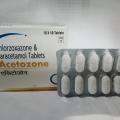Home / Categories / POLAZOX TABLET

POLAZOX TABLET
(20X10'S)
PARACETAMOL-500MG
CHLORZOXAZONE-250MG
NSAID-ANALGESIC+MUSCULAR RELAXANT
CHEMIDRUG INDUSTRIES P. LTD.
Product Details
POLAZOX: CHLORZOXAZONE AND PARACETAMOL
Category: Analgesic–Skeletal muscle relaxant
Accepted
Spasm, skeletal muscle, accompanied by pain (treatment)—Chlorzoxazone and acetaminophen combination is indicated as an adjunct to other measures, such as rest and physical therapy, for relief of pain and muscle spasm associated with acute, painful musculoskeletal conditions.
MOA: Acetaminophen:
The mechanism of analgesic action has not been fully determined. Acetaminophen may act by inhibiting prostaglandin synthesis in the CNS and through a peripheral action by blocking pain-impulse generation. The peripheral action may also be due to inhibition of the synthesis of prostaglandins, or to inhibition of the synthesis or actions of other substances, which sensitize pain receptors to mechanical or chemical stimulation.
CHLORZOXAZONE
| (klor-ZOX-uh-zone) |
| Paraflex, Parafon Forte DSC, Remular-S |
| Class: Skeletal muscle relaxant/Centrally acting |
 Action Action may be related to its sedative properties or to inhibition of reflex arcs at spinal cord and subcortical levels of brain.
Action Action may be related to its sedative properties or to inhibition of reflex arcs at spinal cord and subcortical levels of brain.
 Indications Relief of discomfort associated with painful musculoskeletal conditions.
Indications Relief of discomfort associated with painful musculoskeletal conditions.
 Contraindications Standard considerations.
Contraindications Standard considerations.
ADULTS: PO Initial (for acute pain): 500 mg tid-qid; increase to 750 mg if needed. As improvement occurs, reduce dose; 250 mg tid-qid is usually sufficient.
Alcohol and other CNS depressants: Additive CNS depressant effects may occur.
 Lab Test Interferences None well documented.
Lab Test Interferences None well documented.
CNS: Drowsiness; dizziness; lightheadedness; malaise; overstimulation. DERM: Allergic-type skin rashes; petechiae. GI: GI disturbances. GU: Urine discoloration (orange or purple red). HEPA: Drug-induced hepatitis. OTHER: Hypersensitivity (eg, angioneurotic edema; anaphylaxis).
Pregnancy: Pregnancy category undetermined. Lactation: Undetermined. Hepatic impairment: Avoid use in patients with liver impairment; discontinue if signs of dysfunction occur. Hazardous tasks: May impair ability to perform tasks requiring mental or physical coordination or dexterity, including driving. Drowsiness is very common.
| PATIENT CARE CONSIDERATIONS |
|
- Give with meals to avoid GI upset.
- Discuss dosage adjustments with physician according to patient's response.
- Notify physician if patient is pregnant or nursing.
- Obtain patient history, including drug history and any known allergies.
- Monitor skin and sclera for jaundice.
- Monitor liver function throughout therapy.
- Report signs of liver dysfunction to physician.
|
||||
- Instruct patient to inform physician of any urticaria, redness or itching.
- Tell patient to report to physician any yellowing of skin or eyes.
- Advise patient that drug may cause drowsiness and to use caution while driving or performing other tasks that require mental alertness.
- Advise patient to avoid intake of alcoholic beverages and other medications that cause drowsiness while taking product.
- Advise patient to notify physician before discontinuing medication.
- Inform patient to take a missed dose as soon as possible, unless several hours have passed. Advise patient not to double doses.
- Inform patient urine may turn orange or purple-red while taking this medication.
- Instruct patient to take with meals to avoid GI upset.
Books@Ovid
Copyright © 2003 Facts and Comparisons
David S. Tatro
A to Z Drug Facts
Substitutes

 Route/Dosage
Route/Dosage Interactions
Interactions Adverse Reactions
Adverse Reactions Precautions
Precautions Administration/Storage
Administration/Storage Assessment/Interventions
Assessment/Interventions Patient/Family Education
Patient/Family Education
